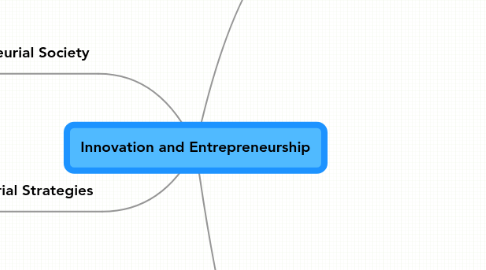
1. Entrepreneurial Strategies
1.1. Being "Fustest with the Mostest"
1.2. "Hitting them where they ain't"
1.2.1. Creative Imitation
1.2.2. Entrepreneurial Judo
1.3. Finding and occupying a specialized Ecological Niche
1.3.1. the Toll-gate strategy
1.3.2. the Specialty Skill strategy
1.3.3. the Specialty Market strategy
1.4. Changing the economic characteristic of a Product, Market, or Industry
1.4.1. by Creating Utility
1.4.2. by Pricing
1.4.3. by Adaptation to Customer's Social and Economic Reality
1.4.4. by Delivering what represents True Value to the Customer
2. Entrepreneurial Society
2.1. What will not work
2.2. Social innovation Needed
2.2.1. Take care of Redundant Workers
2.2.2. Organize systematic abandonment of outworn social policies and obsolete public-service institutions
2.3. New Tasks
2.4. The Individual in the Entrepreneurial Society
3. Practice of Innovation
3.1. Systematic Entrepreneurship
3.2. Purposeful Innovation
3.3. 7 Sources of Innovative Opportunity
3.3.1. The Unexpected
3.3.1.1. Unexpected Success
3.3.1.2. Unexpected Failure
3.3.1.3. Unexpected Outside Event
3.3.2. Incongruities
3.3.2.1. Incongruous Economic Realities
3.3.2.2. Incongruities between Reality and Assumptions about it
3.3.2.3. Incongruities between Perceived and Actual Customer Values and Expectations
3.3.2.4. Incongruity Within the Rhythm or Logic of a Process
3.3.3. Process Need
3.3.3.1. The Automobile story
3.3.3.2. The opportunity
3.3.3.3. When Industry Structure Changes
3.3.4. Industry and Market Structures
3.3.5. Demographics
3.3.6. Changes in Perception, Meaning, and Mood
3.3.6.1. "The glass is Half-full"
3.3.6.2. The problem of Timing
3.3.7. New Knowledge
3.3.7.1. The characteristics of Knowledge-based Innovation
3.3.7.2. Convergences
3.3.7.3. What Knowledge-based innovation requires
3.3.7.4. The unique Risks
3.3.7.5. The Shakeout
3.3.7.6. The Receptivity gamble
3.4. The Bright Idea
3.5. Principles of Innovation
3.5.1. DO's
3.5.1.1. Systematic search/analysis
3.5.1.2. Innovation is both conceptual and perceptual: go out to look, ask, and listen
3.5.1.3. Innovation has to be simple and focused
3.5.1.4. Effective innovation starts small
3.5.1.5. Successful innovation aims at leadership
3.5.2. DONT's
3.5.2.1. Don't try to be clever!
3.5.2.2. Don't try to do too many things at once!
3.5.2.3. Don't try to innovate for the future! Innovate for the present.
3.5.3. 3 Conditions
3.5.3.1. Innovation is work
3.5.3.2. Innovators must build on their strengths
3.5.3.3. Innovation has to be market-driven: it is an effect in economy and society, a change in people's behavior or in a process
3.5.4. The Conservative Innovator
4. Practice of Entrepreneurship
4.1. Entrepreneurial Management
4.2. Entrepreneurial Business
4.2.1. Entrepreneurial Policies
4.2.2. Entrepreneurial Practices
4.2.3. Measuring Innovative Performance
4.2.4. Structures
4.2.5. Staffing
4.2.6. DON'T's
4.2.6.1. Don't mix managerial and entrepreneurial units
4.2.6.2. Don't take existing business out of its own field (into innovative efforts)
4.2.6.3. Avoid making one's own business entrepreneurial by "buying in" (acquiring small entrepreneurial ventures)
4.3. Entrepreneurship in the Service Institution
4.3.1. Challenges
4.3.1.1. Public-service institutions are based on a "budget" rather than being paid out of its results
4.3.1.2. A service institution is dependent on a multitude of constituents
4.3.1.3. Public-institutions exist after all to "do good" (they tend to see their mission as a moral absolute, rather than as economic and subject to cost/benefit calculus)
4.3.2. Entrepreneurial Policies
4.3.2.1. Clear definition of its Mission
4.3.2.2. Realistic statement of Goals
4.3.2.3. Clearly defined Objectives, used as measure of its performance
4.3.2.4. Built into Policies and Practices the constant search for Innovative Opportunity
4.3.3. The Need to Innovate
4.4. New Venture
4.4.1. needs to Focus on the Market
4.4.2. needs Financial Foresight (especially Cash Flow and Capital Needs)
4.4.3. needs to build a top Management Team long before the venture actually needs and affords one
4.4.4. needs a decision from the founding entrepreneur on role, area of work, and relationships
4.4.4.1. the Need for Outside Advice
